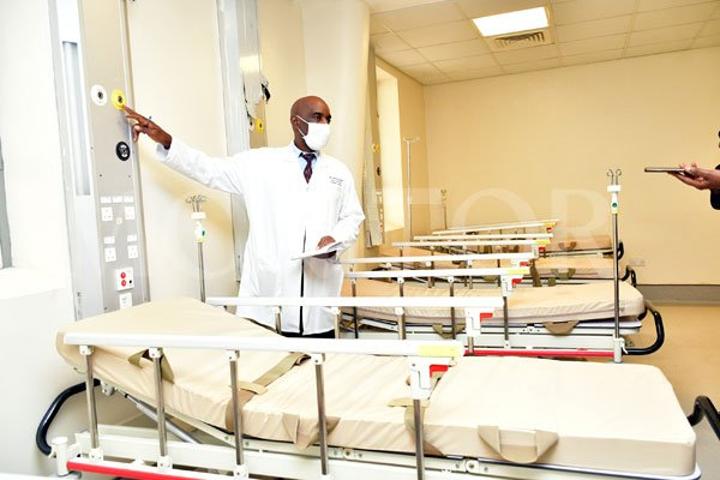Africa-Press – Uganda. Mulago National Referral Hospital yesterday unveiled a new Accident and Emergency (AE) unit which has modern equipment and the capacity to handle 65 critically ill patients.
The spacious unit at the lower part of the facility has two theatres, resuscitation beds, the computed tomography (CT) machine, sick bays, and an information and communications (ICT) system to increase efficiency in saving the lives of very sick patients.
READ: Inside the sickness at Mulago Hospital
Dr John Ssekabira, the acting deputy director of the hospital in charge of clinical services, yesterday said the new unit is a great boost because the current AE unit at upper Mulago is overwhelmed with patients.
“We receive on average 50 patients per day at the [old] AE unit in upper Mulago. The bed capacity of the unit is 30 but due to huge numbers, we often double the number of people accommodated to 60,” he told journalists after a guided tour of the new unit.
“This [new] side has 65 beds where the patients are resuscitated and stabilised for 24 hours before they are taken to theatre or Intensive Care Unit or to the wards [depending on their condition and medical need],” he added.
The unveiling of the unit comes amid the reported rise in cases of accidents in the country.
The recently released annual crime report for 2020-2021 indicates that there was a 42 percent increase in the number of crashes reported in 2021 (17,443 up from 12,249 in 2020).
The number of fatal accidents registered also swelled from 3,269 in 2020 to 3,757 in 2021, serious accidents from 5,803 in 2020 to 9070 in 2021, and minor accidents from 12,249 in 2020 to 17,443 in 2021, according to the report.
Dr Rosemary Byanyima, the hospital’s acting executive director, said the new unit will be fully operational next month.
Some patients are already getting CT scan services at the unit but the theatres and other medical care wings have not yet begun operating.
“When we started the renovation of lower Mulago and the remodelling, we shifted services to different units, including Kawempe and Kiruddu and also upper Mulago. So we had to remodel the current AE to be able to continue tooffer a service. Now is the time to reoccupy the lower Mulago, the AE unit,” she said.
Adjustments
But the management will retain the AE unit at upper Mulago as the filter unit where all emergencies will be received and assessed so that those patients who require to be resuscitated and hospitalised are the ones who are transferred to the new unit.
“So there will be very intense screening and triage system in upper Mulago and then the medical workers there will write proper referral forms and those patients will be sent to lower Mulago,” Dr Byanyima said.
She added: “When we had bomb blast in town, we received more than 80 patients but only about 50 percent needed to be hospitalised overnight as in patients. Most of the patients needed daycare and their discharge forms. Those are the types of patients we want to care for at upper Mulago so that a few who need specialised care are the ones transferred down to lower Mulago. It will be the same for medical emergencies.”
She said they are doing this to ensure they don’t again congest the new AE unit with minor cases which can be cared for at upper Mulago. Patients will not pay for the services, according to the management.
The acting executive director said they are also working with the nursing team, the Ministry of Health and Health Service Commission, to make sure we have enough human resources to reduce the number of relatives of the patients crowding the hospital.
“This [crowding] becomes a problem because it compromises on the care. So we want to introduce the one patient one attendant policy and even give a card to the attendant. Sometimes the number of attendants is so big and medical workers have no access to the patient,” Dr Byanyima said.
COST OF THE UNIT
Mr David Nuwamanya, the hospital principal administrator, said the government spent about $2m (Shs7.4b) to establish the unit. He said the money is from a $35m (Shs130b) loan the government got from the African Development Bank to renovate Mulago Hospital. “We have equipped our Accident and Emergency [unit] to a level that is the international standard by using what is expected in the resuscitation unit or any modern accident and emergency unit. We use transport stretchers for ease of resuscitation of patients as opposed to beds,” Dr Nuwamanya said.
He added: “This stretcher can be manipulated easily to a position the doctor wants the patient to be. You can also move this stretcher to the lab or CT scan without compromising the safety of the patient. This also prevents hospital-acquired infections. These 65 stretchers are from the Czech Republic and each one costs around $15,000 (Shs54m) to give us the right quality and durability.”
For More News And Analysis About Uganda Follow Africa-Press






